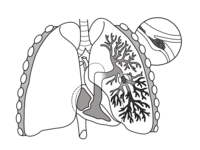
Photo from wikipedia
Objectives Acute pulmonary thromboembolism is a fatal condition with high mortality rate in patients with hemodynamic collapse. Early diagnosis and aggressive treatment after circulatory collapse due to pulmonary thromboembolism are… Click to show full abstract
Objectives Acute pulmonary thromboembolism is a fatal condition with high mortality rate in patients with hemodynamic collapse. Early diagnosis and aggressive treatment after circulatory collapse due to pulmonary thromboembolism are important. Although catheter-directed therapy or surgical thromboembolectomy could be considered, the prognosis of such cases is poor. Methods We reviewed nine consecutive patients who underwent surgical intervention for acute pulmonary thromboembolism requiring cardiopulmonary resuscitation from March 2010 to May 2017. The patients’ demographics, risk factors, operative and postoperative outcomes were retrospectively analyzed. All nine patients who experienced cardiopulmonary arrest or pulseless electrical activity had received cardiopulmonary resuscitation, including endotracheal intubation with cardiac massage. Computed tomography revealed massive pulmonary thromboembolism. Percutaneous cardiopulmonary support was initiated in six cases. Pulmonary thromboembolectomy was performed on a beating heart without aortic cross-clamping in all patients Results The mean operation time was 251.9 ± 74.7 min. Among the six patients who received preoperative percutaneous cardiopulmonary support, three were able to wean off cardiopulmonary bypass during the surgery. The other three cases were able to wean off within 3 days postoperatively. The mean postoperative intubation time was 56.3 h. No mortality was observed. All patients were discharged with New York Heart Association functional class I without any neurological complications. No patients developed major and residual thrombi in the pulmonary artery upon postoperative computed tomography. Conclusions Pulmonary thromboembolectomy on a beating heart for acute pulmonary thromboembolism may be beneficial for minimizing right ventricular damage and improving clinical outcomes.
Journal Title: General Thoracic and Cardiovascular Surgery
Year Published: 2019
Link to full text (if available)
Share on Social Media: Sign Up to like & get
recommendations!